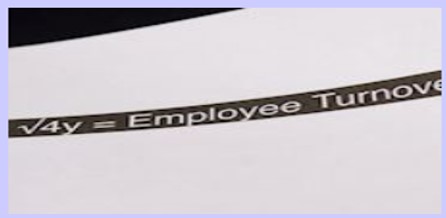You’ve probably seen estimates that employee turnover costs an employer as much as $30,000 per lost-and-replaced employee. Other times you might see an estimate of $10,000 to $30,000 as the cost of replacing an employee who leaves.
These figures seem astounding. How can you know how much employee turnover is costing your business? And what might you do to lower the costs?
The cost of turnover is an elusive figure that can sabotage your bottom line without you ever seeing it. It doesn’t show up as a line item on your financial statement.
It can take more than a year for a new employee to reach maximum efficiency. So when you lose an experienced employee it means lost productivity or lost sales while you’re rehiring, retraining, and while your new employee is gaining experience.
Experts suggest that as much as 80 percent of turnover cost is hidden. Though estimates vary, it’s clear that reducing turnover expenses is important to your bottom line.
| Turnover Cost
Formula Example A. Annual pay for the position $18,000 B. Annual benefits, taxes, insurance cost for the position $5,400 C. Total pay, benefits, taxes, insurance (A+B) $23,400 D. Percent of first year that new employee is unproductive 25% E. Cost of unproductive time (CxD) $5,850 F. Recruiting (such as advertising) $500 G. Management cost to recruit, interview, train, and supervise new employee (Hours in first year [50] x hourly management rate $50) $2,500 Estimated Turnover Cost (E+F+G) = $8,850 |
How to Reduce Turnover Costs:
- Determine what turnover is costing you in total dollars. (Use the formula shown in the right-hand box.)
- Invest more time, money and effort up front to recruit, select and train better people, who can reach maximum productivity sooner.
- Avoid hiring applicants with a job-hopping work history. If you must hire job-hoppers — because of a tight labor market, for example — lower their pay and benefits to compensate for the increased turnover cost.
- Encourage referrals from your present employees.
- Do exit interviews of departing employees, to learn more about what causes employees to leave. Then, when possible, correct practices that cause employees to leave.
- Listen to all complaints from your employees. Correct legitimate problems quickly.
- Cross-train your employees to do several jobs, so that different employees can rotate boring tasks.
- Rotate undesirable jobs among several employees.
- Allow employees flexibility in how they perform their work.
- Have a promote-from-within policy.
